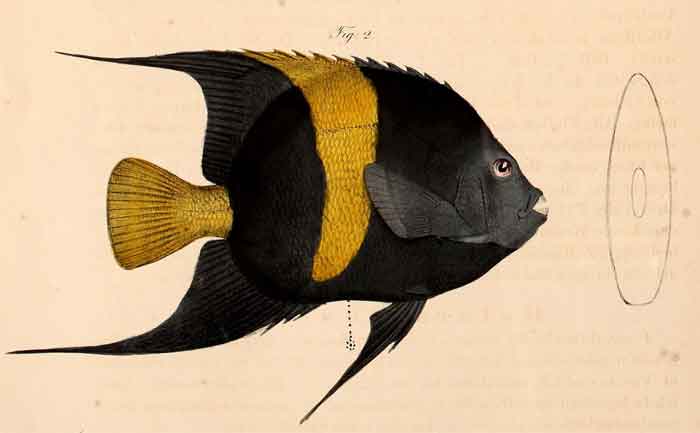
Pomacanthus asfur (*)
Superregnum: Eukaryota
Cladus: Unikonta
Cladus: Opisthokonta
Cladus: Holozoa
Regnum: Animalia
Subregnum: Eumetazoa
Cladus: Bilateria
Cladus: Nephrozoa
Superphylum: Deuterostomia
Phylum: Chordata
Subphylum: Vertebrata
Infraphylum: Gnathostomata
Megaclassis: Osteichthyes
Superclassis/Classis: Actinopterygii
Classis/Subclassis: Actinopteri
Subclassis/Infraclassis: Neopterygii
Infraclassis: Teleostei
Megacohors: Osteoglossocephalai
Supercohors: Clupeocephala
Cohors: Euteleosteomorpha
Subcohors: Neoteleostei
Infracohors: Eurypterygia
Sectio: Ctenosquamata
Subsectio: Acanthomorphata
Divisio/Superordo: Acanthopterygii
Subdivisio: Percomorphaceae
Series: Eupercaria
Ordo: Perciformes
Subordo: Percoidei
Superfamilia: Percoidea
Familia: Pomacanthidae
Genus: Pomacanthus
Species: Pomacanthus asfur
Name
Pomacanthus asfur (Forsskål, 1775)
Synonymy
Chaetodon asfur Forsskål, 1775: XIII, 61 ["Chætodon asfur"] (protonym)
References
Primary references
Forsskål, P. 1775. Descriptiones animalium avium, amphibiorum, piscium, insectorum, vermium; quae in itinere orientali observavit. Post mortem auctoris edidit Carsten Niebuhr. Ex Officina Mölleri: Hauniae [=Copenhagen]. 1–20 + i–xxxiv + 1–164 + 1 map. BHL Reference page. [original description: p. XIII, p. 61]
Vernacular names
English: Arabian Angelfish

Pomacanthus asfur, the Arabian angelfish, is a species of marine ray-finned fish, a marine angelfish belonging to the family Pomacanthidae. It is found in the Western Indian Ocean.
Description
Pomacanthus asfur has a completely different colour and pattern as a juvenile from that of the adult. Juveniles have a blue body which is marked with pale-blue and white stripes. As they mature they develop yellow markings on their dorsal and caudal fins. Until as fully mature adults they have an overall dark blue body with a blackish face, a yellow caudal fin and a broad crescent-shaped yellow band running vertically across the flanks.[3] The dorsal fin has 12 spines and 19–20 soft rays while the anal fin has 3 spines and 19–20 soft rays, the pectoral fins each contain 17 or 18 rays.[4] This species attains a maximum total length of 40 cm (16 in).[2]
Distribution
Pomacanthus asfur is principally found in the western Indian Ocean. Here it is found in the Red Sea and the Gulf of Aden and along the coast of eastern Africa as far south as Zanzibar.[1] It has been recorded, as a probable release of aquarium specimens, on a few occasions off the eastern coast of Florida[4] and from Malta.[5]
Habitat and biology
Pomacanthus asfur has been recorded at depths between 3 and 30 metres (9.8 and 98.4 ft).[1] It is a common species where there are relatively sheltered inshore reefs which have rich growth of soft and hard corals with a few patches of silty seabed. Their diet is dominated by sponges and tunicates.[2] It is a solitary and shy fish that divers find difficult to approach \and it is normally recorded near caves or crevices in the reef.[1] This species is a protogynous hermaphrodite, the larger fish in a pair will change sex to become male.[6]
Systematics
Pomacanthus asfur had its first formal described published in 1775 by the Danish zoologist Johan Christian Fabricius (1745–1808) but it has commonly been attributed to Finnish born Swede Peter Forsskål (1732–1763) the type locality is given as Al-Luhayya in Yemen.[7] Some authorities place this species in the subgenus Arusetta, of which it is the type species[8] The specific name asfur is this species Arabic name in Yemen.[9]
Utilisation
Pomacanthus asfur is infrequently found in the aquarium trade.[1] It has been bred in captivity and captive bred specimens are sometimes marketed as "half-moon angelfish".[3]
References
Pyle, R.; Rocha, L.A.; Craig, M.T. (2010). "Pomacanthus asfur". IUCN Red List of Threatened Species. 2010: e.T165839A6145733. doi:10.2305/IUCN.UK.2010-4.RLTS.T165839A6145733.en. Retrieved 19 November 2021.
Froese, Rainer; Pauly, Daniel (eds.) (2019). "Pomacanthus asfur" in FishBase. December 2019 version.
"Pomacanthus asfur". Saltcorner!. Bob Goemans. 2012. Retrieved 28 February 2021.
"Pomacanthus asfur (Forsskål, 1775)". Nonindigenous Aquatic Species. USGS. Retrieved 28 February 2021.
P.K. Karachle; A. Angelidis; G. Apostolopoulos; et al. (2016). "New Mediterranean Biodiversity Records (March 2016)". Mediterranean Marine Science. 17 (1): 230–252. doi:10.12681/mms.1684. hdl:2445/105358.
"Pomacanthus asfur". reefapp.net. Retrieved 28 February 2021.
Eschmeyer, William N.; Fricke, Ron & van der Laan, Richard (eds.). "Species in the genus Pomacanthus". Catalog of Fishes. California Academy of Sciences. Retrieved 28 February 2021.
Eschmeyer, William N.; Fricke, Ron & van der Laan, Richard (eds.). "Genera in the family Pomacanthidae". Catalog of Fishes. California Academy of Sciences. Retrieved 28 February 2021.
Christopher Scharpf & Kenneth J. Lazara (21 July 2020). "Order ACANTHURIFORMES (part 1): Families LOBOTIDAE, POMACANTHIDAE, DREPANEIDAE and CHAETODONTIDAE". The ETYFish Project Fish Name Etymology Database. Christopher Scharpf and Kenneth J. Lazara. Retrieved 28 February 2021.
Retrieved from "http://en.wikipedia.org/"
All text is available under the terms of the GNU Free Documentation License

